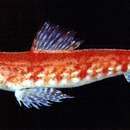Diagnostic Description
provided by Fishbase
Fine barring on head. Body bands darken towards the tail (Ref. 48635).
Trophic Strategy
provided by Fishbase
Lives in sandy or rocky places. A carnivore that feeds on fish (Ref. 9137).
- Recorder
- Drina Sta. Iglesia
Biology
provided by Fishbase
Lives in coastal reef flats (Ref. 48635) in sandy or rocky places. A carnivore which feeds on fish (Ref. 9137). Pelagic spawner (Ref. 35298). Benthic (Ref. 58302).
Comprehensive Description
provided by Smithsonian Contributions to Zoology
Synodus ulae Schultz, 1953
Synodus ulae Schultz, 1953:38 [Hawaiian Islands].
MATERIAL EXAMINED.—Holotype: USNM 52671, HAWAII. Paratypes: HAWAII (8): USNM 55272 (3), 55376 (4), 58525 (1); JAPAN (2): USNM 59778 (1), 59805 (1). Other Material: JAPAN (14): USNM 64661 (3), 71006 (1); BPBM 18953 (2), 18976 (1); CAS 29706 (5); FMNH 55458 (1); BMNH 1923.2.26.158-9 (1). HAWAII (36): USNM 88134 (2), 143699 (3), 217732 (1); CAS 10492 (1), 11312 (1), 39948-50 (14), 68350 (1); FMNH 47682 (3); ANSP 77716 (1), 80136 (1), 80143-4 (2), 91705 (1), 97780 (2), 97832 (3).
DIAGNOSIS AND COMPARISONS.—A species of Synodus with the following combination of characters: dorsal-fin rays (branched and unbranched) 13–14 (usually 14); anal-fin rays 8–10 (usually 9); pored lateral-line scales 62–66 (usually 65); transverse scale rows 5.5/8; vertebrae 62–65 (usually 64); combined dorsal and anal procurrent rays 30–38; anterior palatine teeth longest and in a discrete group; peritoneal spots 11–12; posterior pelvic process wide.
Synodus ulae can be separated from all other Indo-West Pacific species of Synodus except S. capricornis by its high lateral-line scale and vertebral counts 62–66, 62–65, respectively. It can be separated from S. capricornis by the nature of the dermal flap on the anterior nares: long and spatulate in S. ulae, short and triangular in S. capricornis.
DESCRIPTION.—Dorsal-fin rays 13–14; anal-fin rays 8–10; pectoral-fin rays 13; pelvic-fin rays 8; procurrent rays 30–38, dorsal 16–19, anal 14–18; lateral line continuous, 62–66 pored scales; scale rows above lateral line from dorsal origin 5.5; scale rows below lateral line to anal origin 8; predorsal scales 19; rows of cheek scales 6–7; vertebrae 62–65; peritoneal spots 11–12.
Percentages of Standard Length: Mean (range): head length 29.9(24.3–33.2); snout length 6.1(5.3–6.7); upper jaw length 19.1(17.1–20.3); diameter of bony orbit 4.9(3.7–6.5); least width of bony interorbital 2.9(2.1–3.6); snout to dorsal origin 43.8(41.0–45.1); snout to adipose origin 87.3(83.2–92.3); snout to anal origin 80.1(77.5–84.4); snout to pelvic insertion 36.4(34.6–38.4); snout to pectoral insertion 28.7(26.0–30.6); first-dorsal-ray length 10.2(8.7–12.3); longest-dorsal-ray length 15.2(13.8–18.5); pectoral-fin length 12.4(10.5–14.5); pelvic-fin length 27.2(23.6–31.2); dorsal-fin base 16.8(14.6–18.5); anal-fin base 8.5(6.3–10.1); based on 20 specimens 69.0 to 242.4 mm SL.
Body fusiform, head somewhat depressed, caudal region a little compressed. Large cycloid scales on body, extending onto cheeks and operculum, postoral portion of cheeks naked. Snout sharply pointed, broader than long; the anterior nostril on each side bearing a long spatulate dermal flap on posterior border, extending well beyond anterior edge of nares when depressed anteriorly. Interorbital space concave, occipital region bony. Palatine teeth in an elongate V-shaped pad, teeth pointing backwardly, those in front largest and in a discrete group. Lingual teeth well developed, those on free end of tongue largest and about 50 in number. Teeth caniniform, larger teeth with arrow-shaped tips. Pectoral fins reaching a line from base of pelvic fins to origin of dorsal fin. Outer pelvic ray unbranched and short, the fifth branched ray (sixth ray) longest. Posterior bony process of pelvic girdle broad. Peritoneum pale.
COLOR PATTERN.—Preserved material as in S. variegatus.
DISTRIBUTION AND HABITAT.—This species has been collected only in Japan, Okinawa, and Hawaii, and may be restricted to that range. Depth of capture data is lacking for most of the collections examined with a range from “tidepool” to 66 fms given for only three of the 31 collections studied. Several collections were mixed with S. variegatus, however, indicating that S. ulae is found in shallow water.
- bibliographic citation
- Cressey, Roger F. 1981. "Revision of Indo- West Pacific lizardfishes of the genus Synodus (Pisces: Synodontidae)." Smithsonian Contributions to Zoology. 1-53. https://doi.org/10.5479/si.00810282.342
分布
provided by The Fish Database of Taiwan
分布於太平洋海域,由日本、臺灣至夏威夷海域。臺灣分布於南部及東北部海域。
利用
provided by The Fish Database of Taiwan
偶為底拖網或延繩釣捕獲,可食用。
描述
provided by The Fish Database of Taiwan
體圓而瘦長,呈長圓柱形,尾柄兩側具稜脊。頭較短。吻圓,吻長明顯大於眼徑。前鼻孔瓣寬長,似抹刀狀。眼中等大;脂性眼瞼發達。口裂大,上頜骨末端遠延伸至眼後方;頜骨具銳利之小齒;腭骨前方齒較後方齒長,明顯自成一叢。體及頭部被圓鱗;頰部被鱗,但不及前鰓蓋緣;側線鱗數
60-66;側線上鱗數 5.5(少數為
6.5)。單一背鰭,具軟條13-14(通常為14);有脂鰭;臀鰭與脂鰭相對,具軟條8-11;胸鰭短,末端不延伸至腹鰭起點與背鰭起點之連線;尾鰭叉形,上葉等長於下葉。體側上部淡黃褐色,下部白色,具多條不規則之黑斑帶;體側中部不具褐縱帶;各鰭透明,具斑點狀縱帶。
棲地
provided by The Fish Database of Taiwan
主要棲息於沿近海靠近礁石之砂泥底質海域。屬肉食性,以小型魚類及甲殼類為主。通常在砂地上停滯不動,身上的花紋是很好的偽裝,有時會將整個身體埋入砂中而只露出眼睛,等候獵物游經時,躍起吞食。
Red lizardfish: Brief Summary
provided by wikipedia EN
The red lizardfish (Synodus ulae) is a species of lizardfish that lives mainly in the western Pacific Ocean.
- license
- cc-by-sa-3.0
- copyright
- Wikipedia authors and editors

